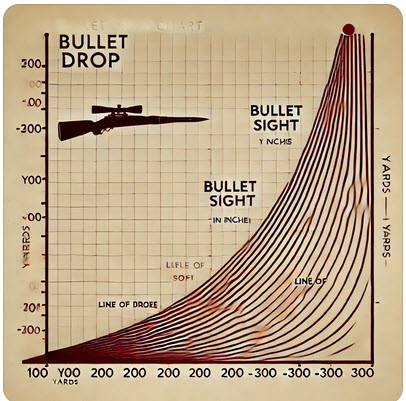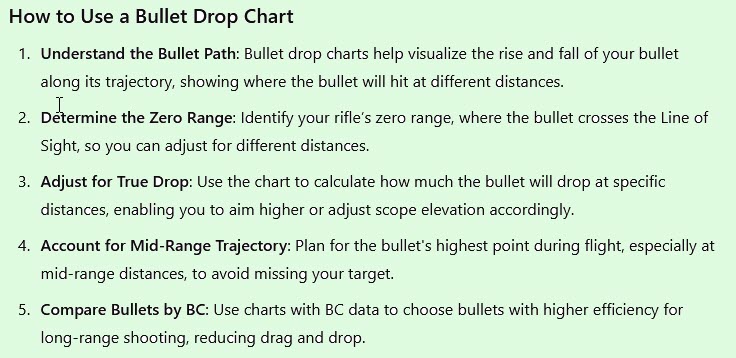Mastering Bullet Flight
Let’s cut right to the chase: If you want to hit your target consistently and accurately, you need to understand what happens after the bullet leaves the gun. It’s not enough to simply aim and pull the trigger—you’ve got to grasp the science of external ballistics. Every shot is a battle against bullet drop, air resistance, and physics, and the shooter who knows how to work with those forces instead of against them has a distinct advantage.
What is External Ballistics?
External ballistics is the study of how a bullet behaves once it exits the muzzle of your gun. It encompasses the forces and factors that impact a bullet’s trajectory toward the target. In simpler terms: it’s all about how to make sure your bullet lands exactly where you want it to.
Let’s break it down into terms that matter for precision shooting.
Key Terms in External Ballistics
- Line of Sight
The line of sight is a perfectly straight line from your eye, through your sights, and to the target. It’s what you see when you aim, but here’s the kicker: the bullet’s actual bullet path doesn’t follow this line. We need to account for external factors that alter where the bullet will go.
- Line of Bore
This is the straight line running through the center of your gun’s barrel. It doesn’t match the line of sight because the barrel points slightly upward to compensate for the bullet drop caused by gravity.
- True Drop
Gravity is always working. As soon as the bullet leaves the barrel, it starts dropping. True drop refers to how much the bullet falls over a given distance, and it’s always happening, whether the bullet is flying upward or downward. This is key in understanding bullet trajectory.
Here’s a simple experiment: Fire a bullet perfectly level, and at the same time, drop an identical ball from the same height. Both will hit the ground at the same time because they’re both affected by gravity in the exact same way.
- Bullet Path
This is where the real magic happens. The bullet path is the actual curved line the bullet follows as it moves through the air. Factors like velocity, wind, and gravity shape this trajectory, and understanding how these forces interact is critical for hitting your mark.
Why the Bullet Drops—and What You Can Do About It
Let’s be real—gravity never takes a break. In our example, a .600 round ball traveling at 1247 feet per second drops 7.55 inches by the time it reaches 75 yards. But shooters don’t just aim straight and hope for the best. We cheat. We aim higher to compensate for this bullet drop and align our sights so that our line of sight hits the target dead-on.
This is why your bullet crosses your line of sight twice—once as it rises (near zero) and again as it falls (far zero). This process allows you to aim directly at the target at a set distance, say 75 yards, and have the bullet strike exactly where you want it.
The Role of Bullet Velocity and Drag
Here’s the deal: a faster bullet stays flatter for longer because it covers more ground before gravity has a significant effect. But as the bullet slows down, drag (air resistance) becomes a bigger factor, causing the bullet trajectory to curve more dramatically downward.
Why does one bullet slow down faster than another? It comes down to drag and inertia. A bullet’s shape and weight determine how much it resists slowing down. A streamlined bullet cuts through the air with less drag, meaning it maintains speed better than a blunt, irregularly shaped one like a round ball.
Bullet Drop Charts: A Shooter’s Essential Tool for Precision
For any shooter serious about accuracy, bullet drop charts are indispensable. They provide a visual representation of a bullet’s trajectory from muzzle to target, helping you account for the inevitable effect of gravity on the bullet’s flight. Whether you’re shooting at short or long ranges, a bullet drop chart helps you calculate how much higher you need to aim to compensate for the bullet’s downward arc over distance.
What Is a Bullet Drop Chart?
A bullet drop chart graphically illustrates the relationship between range and the vertical displacement (drop) of the bullet. The chart typically shows how much a bullet will drop in inches or millimeters at different distances, such as 100 yards, 200 yards, and beyond. This lets shooters make the necessary adjustments to their sights or optics, ensuring the bullet strikes the intended target.
When you fire a round, gravity begins pulling it downward immediately. The farther the bullet travels, the more it drops, which means you need to aim higher at longer ranges. This is why ballistic charts or bullet drop tables are so useful; they allow you to predict the bullet’s trajectory based on data like:
- Muzzle velocity (the speed of the bullet as it leaves the barrel)
- Ballistic coefficient (how well the bullet cuts through the air)
- Caliber and weight of the bullet
- Range (distance to target)
How to Use a Bullet Drop Chart
Once you have a bullet drop chart, it’s all about interpreting the data. Let’s say your chart shows that at 100 yards, your bullet will drop 2 inches. You know that to hit a target at that range, you’ll need to adjust your sights or optic reticle up by 2 inches. Many shooters pair this data with ballistic calculators or apps for even greater accuracy in real-time shooting conditions.

Creating Your Own Bullet Drop Chart
You can create a custom bullet drop chart using online ballistics calculators. Input your rifle’s specs, the ammunition you’re using, and environmental factors like altitude and wind. The tool will generate a chart that gives you precise bullet drop data for different ranges.
Whether you’re into long-range precision shooting or just want to understand your firearm’s performance better, bullet drop charts are a critical resource. By mastering how to read and apply them, you’ll improve your accuracy and consistency on the range or in the field.
Ballistic Coefficient: The Bullet’s Efficiency
The Ballistic Coefficient (BC) is a measurement of how efficiently a bullet travels through the air. A BC of 1.0 means a bullet performs as well as the “standard” bullet used in ballistics testing. Anything less than 1.0 means it’s losing speed faster due to drag. For example, a round ball fired from a black powder gun has a much lower Ballistic Coefficient than a sleek, high-velocity bullet fired from a modern rifle.
Wrapping It All Up
External ballistics is the science of controlling the uncontrollable. Gravity, drag, and other forces will always act on your bullet, but understanding these factors gives you the power to put that bullet right where you want it. So next time you step up to the line, remember: mastery of external ballistics is what separates the consistent shooter from the rest of the pack.
If you’ve paid attention to these fundamentals, your target should now look like a masterpiece of precision.



